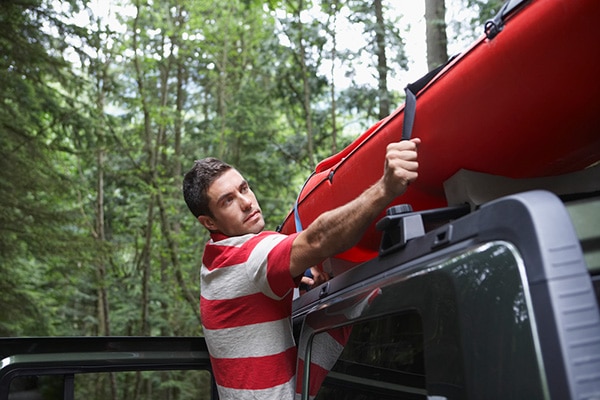Most people getting into sports are often concerned about lifting, carrying, and loading kayaks on their cars.
As excited as you might be to starting your kayaking adventures, you need to figure out how exactly you’ll get your kayak from your garage to the water safely, even if you’re alone.
Mounting a kayak on your car’s roof rack can be challenging, especially if you don’t have help from someone else.
Regardless of your physique, there is a way around easily getting your kayak on a roof rack by yourself without causing damage to the car, hurting your back, or dropping the kayak.
There are methods that make the whole solo loading experience a bit manageable and a pretty straightforward task.
Carrying A Kayak By Yourself
The weight and size of kayaks make it difficult for you to load them up on the roof rack alone, but luckily, there are options of load-assist roof racks that help ease things up.
As long as the kayak is of reasonable size and weight, you can easily transport it by yourself.
However, it’s important to resist any urge you might have to directly lift the kayak from the ground straight to the roof rack, however easy it looks.
Kayaks, however large or small, lightweight or not, are too cumbersome for one person, single-handedly and safely carry from the ground and load on a roof rack.
A sports rack, also called a crossbar roof rack, is the best way to transport a kayak using your vehicle.
Putting a kayak on a roof rack is one of the most important steps towards successfully making it to the kayaking adventure destination.
A roof rack provides the most ideal and secure tie-down for your kayak, and it greatly minimizes any risks of damaging the car during transportation.
First, stand on the kayak’s left side, facing the boat, then slowly squat down and use both hands to grab the cockpit’s edge next to you gently.
It would help if you now pulled the kayaks end up towards your thighs.
Next, use your right arm to grab the boats inside, right by the cockpit’s underside.
After that, gently stand to lift the boat onto your shoulder with the kayak’s cockpit rim resting on your shoulder.
Ensure that the boat is balanced well on your right shoulder to avoid accidental tipping and falling off.

Putting A Kayak On A Roof Rack By Yourself
If you have ever put your coffee on your car’s roof and accidentally driven off without getting it down, you can attest to the mess that ruins an otherwise perfect morning.
In the same light, when you lace your kayak on the roof rack carelessly, you risk it flying off to the highway as you drive.
This could be very tragic as it damages the kayak and is a menace to road safety as well.
As such, it’s advisable to ensure the kayak is properly strapped on your car’s roof and tightly secured to hold it in position.
Before embarking on loading your kayak on your car, it’s best to consult the car’s owner manual to ensure the roof can support the boat’s weight capacity.
In addition, you’ll need a kayak carrier, tie-down straps, bow straps, a tow loop for anchoring, and an optional load assist.
Choosing The Right Gear
As easy as it might seem to load your kayak on your car’s roof, it might take some time to get right.
It is important to do this right to avoid damaging expensive gear, which is guaranteed by knowing what you need and how to use your gear to strap your craft to a roof rack safely.
To some people, gathering the right gear might seem oblivious, but it’s very necessary for the long run.
You can determine the right kayak carrier for your case based on the weight and size of your craft.
If you are transporting a number of kayaks, you’ll need a lot of conveniences to ensure the safety of both the kayak and the roof rack.
However, some types of kayaks are large in size and ultimately not viable to be carried with any roof rack.
There are different styles and types of carriers, even options for when you don’t have a roof rack.
You can also use a foam block carrier if you don’t haul your watercraft as often, which is cost-effective and it allows more room on the roof for your kayak.
Loading Your Kayak
It’s easy to load the kayak on the car, provided the kayak carrier and the roof rack have been pre-installed.
The important thing to remember is not to rush things up, as this could cost you a lot in terms of property damage.
If you plan on directly lying the kayak on the roof rack, use some extra padding in the form of a block or just a rolled-up blanket.
Now that you’re doing this alone, it’s advisable to start at the car’s rear by resting the kayak on the rear roof rack and sliding it frontward smoothly.
It is much easier to load your kayak on a roof rack when the kayak is facing down, as it allows you extra room for strapping.
With the kayak cockpit facing forward, lift the kayak onto the car’s roof gently, taking caution not to harm any of the two.
It would be best if you put your shoulder near the cockpit’s edge to allow an even distribution of the hull’s weight and to allow you to carry the craft with effortlessness.
For safe loading, position yourself at the backside of your vehicle first.
Then, if you have some additional gear or another kayak you’re putting on the roof, place them side by side; otherwise, the kayak should be centered on the car’s roof.
Strapping Your Kayak To The Crossbars
Take your tie-down strap and loop it under the crossbar on the side, then throw the straps across to the other side of your car.
While on the passenger’s side, throw the non-buckle end of the strap to the other side of the car.
Ensure that the strap’s end runs underneath the other side of the crossbar for extra firmness, then fit the end of the strap in the buckle to secure it while taking care not to damage the watercraft.
If there is any extra strap hanging around, secure it as well so that it doesn’t sway in the wind when you’re on the road.
The kayak should be well balanced on the crossbars to avoid toppling off backward or forward, and it should be positioned straight and in line with the car.
Failure to balance it well could cause put pressure unevenly on one side of the craft during the drive, which is risky.
If you want to ease things up further, you can position the straps before the scheduled time for loading the kayak on the roof rack.
As you put the straps on, ensure that they are tight enough and they aren’t flexing to avoid ruining and bending the kayak’s body.
Strapping Down The Bow And Stern
After ensuring the craft is securely resting on the roof rack side to side, you can proceed to secure the back and the front of the kayak.
This requires you to have a bow and stern strap set.
A set of bow and stern straps runs from front to back, keeping the craft from sliding and falling off the back of the car during transportation.
Different cars have different spots for connection, but most of them come with built-in attachment points on the front and rear ends of the vehicle.
If your car doesn’t have these spots, you might have to buy tie-down loops for the hood and trunk.
Next, placing the bow end of your kayak on the bar on the rear roof while ensuring they are safely and securely positioned.
After this, you can move to the stern side of the hull.
Next, lift the kayak’s tern side carefully and slide it forward until it’s secured on the vehicle’s roof rack.
Tidying Up
This is the last step to putting a kayak on a roof rack by yourself, but an important one too.
Tidying up doesn’t necessarily mean cleaning the space around you but also ensuring that everything is set and safe for transportation.
Ensure that the end straps are well secure to avoid flapping and swaying in the wind as you drive as it undermines road safety.
Also, check to ensure the buckles on the ends of the strap don’t scratch or damage the door of your car.
The crossbars of the kayak rack should be tightly fitted for safety purposes, so check to make sure.
If you are a serious paddler, you will want to consider the type and size of the car you buy, as it’ll be very instrumental in transporting your kayak to and from the water.
Kayak and canoe roof racks can be fitted into practically any type of truck, SUV, or car, but there are some manufacturers who choose not to.
If you should have any doubts about whether or not to use your car for this purpose, you can consult the manufacturer’s owner manual or the instruction manual that came with the roof rack or the vehicle.
